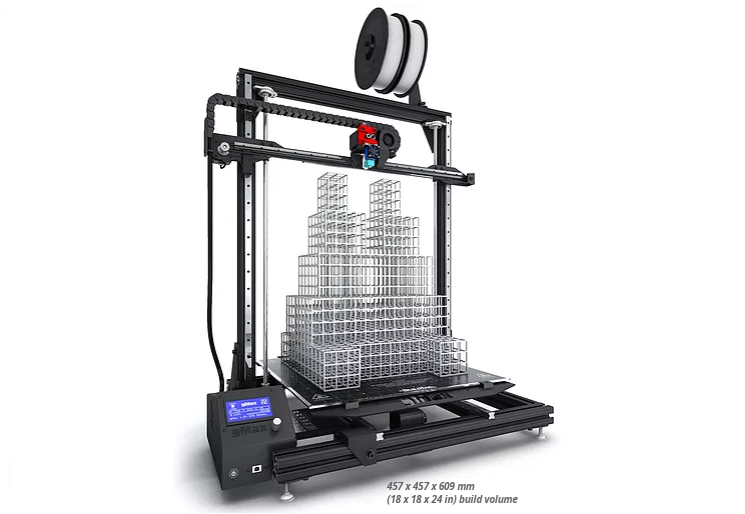Brooklyn 3D printing company gCreate has a several-year history of building super-sized desktop 3D printers, starting with its gMax 1.5 and gMax 1.5 XT in 2014. The gMax 1.5+ and gMax 1.5 XT+ 3D printers were launched the following year. The company has been busy for the past few years, moving to new headquarters, further developing its on-demand large format 3D printing services, and overall expanding its presence both domestically and internationally. As 2019 kicks off, gCreate introduces its newest model, the much-anticipated gMax 2. This machine has been completely redesigned and is bigger than its predecessors, with an 18 x 18 x 24 inch build volume. The gMax 2 also features a true precision linear motion system, a filament runout sensor, and Mosaic Manufacturing Palette 2 compatibility for multi-color and multi-material printing.
 The gMax 2 uses all-metal E3D V6 hot ends that can print at up to 300°C and allow for easily swappable nozzle tips ranging from 0.25 to 1.2 mm. The 3D printer also has an 18 x 18 inch heated bed add-on that, combined with the hot ends, enables users to 3D print with materials such as carbon fiber reinforced nylon, PETG, ASA, TPU and more. The redesigned heated build plate set uses USA-made 4mm borosilicate glass and custom gridded BuildTak sheets like before, but it now also includes a heated mat with an external relay that can be controlled directly from the printer.
The gMax 2 uses all-metal E3D V6 hot ends that can print at up to 300°C and allow for easily swappable nozzle tips ranging from 0.25 to 1.2 mm. The 3D printer also has an 18 x 18 inch heated bed add-on that, combined with the hot ends, enables users to 3D print with materials such as carbon fiber reinforced nylon, PETG, ASA, TPU and more. The redesigned heated build plate set uses USA-made 4mm borosilicate glass and custom gridded BuildTak sheets like before, but it now also includes a heated mat with an external relay that can be controlled directly from the printer.
The five-inch full-color gTouch print management system is powered by Astroprint and allows for cloud capability, print queuing, remote printer control from a mobile device or desktop computer, and video monitoring. The print management system is optimized for gMax 3D printers but can be used with other FDM 3D printers as well, and it can be hooked up to more than 10 printers at one time.
“The gMax 2 is the result of 2 years of testing and improvements. It is a completely redesigned workhorse machine using industry leading components that improve your printing experience at a very competitive price point,” said gCreate Co-Founder Gordon LaPlante.
The gMax 2 retails for $3995.
“To be able to release a machine with so many authentic, high quality components that further increase the incredible performance of this printer while keeping it at such a low cost per cubic inch is something we are very excited to offer to our customers,” said Anna Lee, Co-Founder of gCreate.
All gMax 2 3D printers will be shipped fully assembled, calibrated and pre-tested. Shipping of the gMax 2 is slated for the first quarter of 2019.
What do you think about this new 3D printer? Discuss this news and other 3D printing topics at 3DPrintBoard.com or share your thoughts in the Facebook comments below.
Subscribe to Our Email Newsletter
Stay up-to-date on all the latest news from the 3D printing industry and receive information and offers from third party vendors.
Print Services
Upload your 3D Models and get them printed quickly and efficiently.
You May Also Like
The Market and Industry Potential of Multi-Material 3D and 4D Printing in Additive Electronics
Additive manufacturing leverages computer-based software to create components for products by depositing either dielectric or conductive materials, layer by layer, into different geometric shapes. Since its birth in the 1980s,...
3DPOD 262: Bio-inspired Design for AM with Dhruv Bhate, Arizona State University
Dhruv Bhate is an associate professor at Arizona State University. There, he looks at structures, materials, and design. Previously, he worked at PADT as well as in the semiconductor and...
3DPOD 261: Tooling and Cooling for AM with Jason Murphy, NXC MFG
Jason Murphy´s NXC MFG (Next Chapter Manufacturing) is not a generalist service; instead, the company specializes in making tooling. Using LPBF and binder jet, the company produces some of the...
3DPOD 260: John Hart on VulcanForms, MIT, Desktop Metal and More
John Hart is a Professor at MIT; he´s also the director of the Laboratory for Manufacturing and Productivity as well as the director of the Center for Advanced Production Technologies....


































